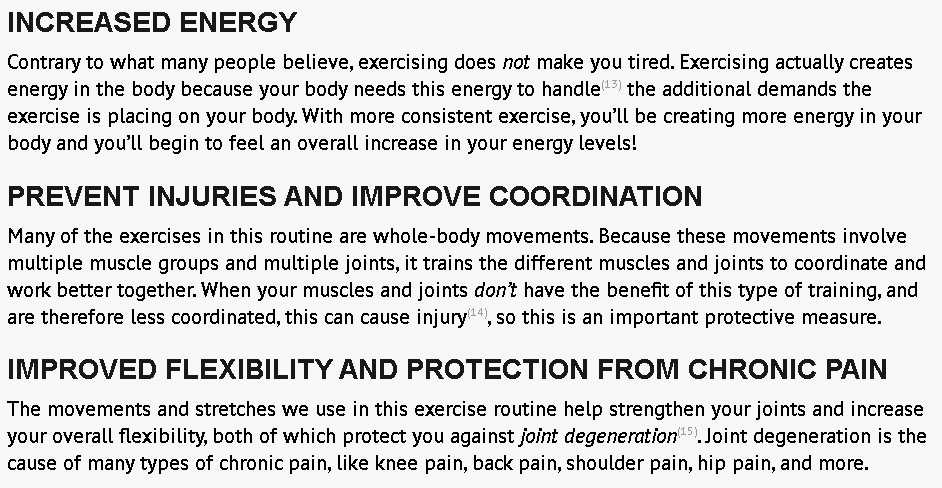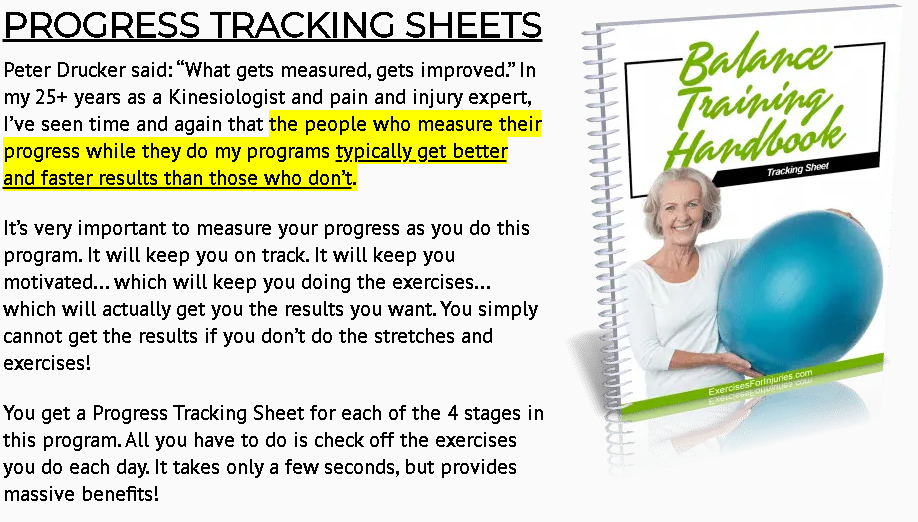
For women and men between the ages of 45 and 85...
Has Balance or Coordination Become a Concern?

Scientific research has shown that you can improve your balance and prevent falls with just a few minutes of easy, gentle exercises each day.
If you’re concerned about your balance or coordination, there are 2 things you NEED TO KNOW.
Most people (and ironically, most doctors and health professionals) don’t know these two things...
but they can have a HUGE impact on your quality of life. In this article, I’m going to walk you through these two important things.
And, I’m also going to show you the MOST EFFECTIVE, EASIEST, and GENTLEST way I’ve ever found (in my 25+ years as a Registered Kinesiologist) for preventing and reversing balance problems, building strength, and protecting yourself against dangerous falls and injuries.
THE #1 THING YOU NEED TO KNOW:
THE “HIDDEN” DANGER OF BAD BALANCE
Recent research shows that balance problems and falling can lead to additional health complications
If you’re between 45 and 85, or you have concerns about your balance, or you’ve already sustained a fall, PLEASE READ THIS CAREFULLY
Several studies have shown that impaired balance and falls can lead to more severe health issues and conditions - both physical and psychological, and can even lead to a downward health spiral(3)(4).
These studies found that:

- Aging (and certain injuries) can cause postural sway and a significant decline in muscle strength... (5)
- Which leads to balance problems and fear of falling... (5)
- Which leads to falls, injuries and more fear of falling... (5)
- Which leads to you doing less physical activity (because you’re afraid of falling)... (5)
- Which leads to further decrease and decline in muscle strength, coordination and balance (because these things all deteriorate without regular physical activity)... (5)
- Which leads to more falls and injuries (because your balance is worse than it’s ever been)...
- Which leads to dependence on others (because you can no longer rely on your own body)...
- Which leads to you wanting to isolate yourself socially (because you feel guilt and shame about being a burden to the people around you)... (6)
- Which can lead to depression. (6)
This quote comes from a 2014 balance and falling study entitled: Analysis of Core Stability Exercise Effect on the Physical and Psychological Function of Elderly Women Vulnerable to Falls during Obstacle Negotiation:

That’s the bad news…
BUT HERE’S THE GOOD NEWS:
That very same 2014 study found that certain types of exercises… ...that are VERY GENTLE, VERY EASY, and require ONLY A FEW MINUTES A DAY… ...can:
- Improve your balance (8)
- Prevent falls (8)
- Prevent (and reverse) that entire negative downward health spiral we discussed above (8)
- Stabilize your core (8)
- Strengthen your legs (8)
- Increase your confidence (8)
- Reduce and remove your fear of falling (8)
- Create a positive, upward health spiral for you! (8)
BUT... here’s the key:
You have to do the right kinds of exercises.
You have to do the exercises that have been studied, researched, and proven to be highly-effective for improving balance. Which leads us to...
THE #2 THING YOU NEED TO KNOW:
Most balance training programs don’t work because they aren’t comprehensive enough (9)(10)
Because most doctors, physical therapists and fitness ‘gurus’ don’t take the time to review and carefully consider the latest research... ...most balance training programs are too narrowly focused, and only offer a few approaches to improving your balance. Most of these program look like this:

...And this is why most balance training programs don’t work - they aren’t comprehensive enough. Because I spent so much time reviewing the scientific and medical research on balance and falling, I learned two important things:
Good balance is the result of multiple different interconnected muscle groups, musculoskeletal systems, and even non-motor, cognitive functions, all working together simultaneously. In other words, strengthening the legs a little and practicing standing on one foot is not enough to improve your balance!
Scientific and medical research has proven that there are multiple different methods that are highly-effective for improving balance and preventing falls.
Using these insights and everything else I learned reviewing the research, I created a balance training program that utilizes 10 different approaches, that all work together, in a cumulative fashion, to improve your balance, restore your confidence, and reduce and remove your fear of falling. My program looks like this:

As you can see, my program is a lot more comprehensive and includes a lot more approaches to improving your balance. It’s not always true in life that more is better, but in this case, it is.
IF YOU’RE WORRIED my program looks TOO comprehensive, and that it will be difficult, complicated or time-consuming, don’t worry.
In spite of the fact that my solution is so comprehensive, the routine you’re going to learn in the program takes only 8 minutes (or less) each day to complete, and is so easy and gentle that virtually any person can do it, regardless of age, weight, fitness level, or flexibility.
In fact, you can do this program if you’re out of shape, you have very little flexibility, and even if you’ve never exercised a day in your life.
This sounds good, but... there’s a problem


Frequently Asked Questions:
You can definitely find exercises for improving your balance online. But, you won’t find a comprehensive program that includes 10 different approaches and 4 separate modalities for improving your balance, strengthening, activating, and training your core, strengthening your lower and upper body, retraining your brain, and more. You won’t find a complete program that has been carefully crafted, based on scientific research and real-world testing, that includes ONLY the necessary exercises, with instructions on how to do them in just the right sequence, with the right number of repetitions and sets. That’s exactly what Balance Training Handbook is.
While many of the exercises and movements in this program are performed with your body only, you will need a basic and inexpensive item like the Stability Ball. This will be covered in the program so you know exactly how to use it. You can purchase the item at the EFI Shopify Store or in most sporting goods stores or on Amazon.com.
Absolutely. This program is very low impact, and uses a gradual progression approach, which means we start out very slowly and gently, and then increase the intensity and duration of the exercises and stretches only as much as you can safely handle.
Each exercise session in this program is designed to take 8 minutes or less to complete. It may take a little longer in the beginning as you’re first learning the stretches and movements, but you’ll have it down to 8 minutes or less in no time because these sequences are very easy to learn.
Although everyone is different and will experience different results, many people experience improvements in their balance in as little as 7 days.
The answer to this is very individual. It depends on what type of injury or surgery you’ve had and how you’ve recovered from them. It’s best to ask your surgeon or doctor to see if this program is suitable for you.
Not at all. These are simple and natural movements that you will easily “get” after one or two viewings of the videos. And each stretch, movement and exercise is very gentle.
You don’t have to wait. The Balance Training Handbook Program is an instant access downloadable program that includes videos and manuals.
The ebooks are in the format of adobe acrobat PDF, which can be viewed on Mac or PC. The video format is M4V which can be viewed on Mac, PC, computer, tablet or smartphone.
No, you can watch the videos whenever you like (even at 3 am), do parts and pieces whenever you have time, do everything at your own pace, and revisit any aspects of the videos anytime.
The chances are very good that it will work for you, but just so you feel totally comfortable… if you decide, for any reason, or no reason at all, that you’d rather get your money back, we will refund all your money, no questions asked, as long as you contact us within 60 days of your date of purchase.








- Deger TB, Saraç ZF, Savas ES, Akçiçek SF. The Relationship of Balance Disorders with Falling, the Effect of Health Problems, and Social Life on Postural Balance in the Elderly Living in a District in Turkey. Geriatrics (Basel). 2019;4(2):37. Published 2019 May 17. doi:10.3390/geriatrics4020037
- Marchetti GF, Whitney SL, Redfern MS, Furman JM. Factors associated with balance confidence in older adults with health conditions affecting the balance and vestibular system. Arch Phys Med Rehabil. 2011;92(11):1884–1891. doi:10.1016/j.apmr.2011.06.015
- Payette MC, Bélanger C, Léveillé V, Grenier S. Fall-Related Psychological Concerns and Anxiety among Community-Dwelling Older Adults: Systematic Review and Meta-Analysis. PLoS One. 2016;11(4):e0152848. Published 2016 Apr 4. doi:10.1371/journal.pone.0152848
- Carpenter MG, Adkin AL, Brawley LR, Frank JS. Postural, physiological and psychological reactions to challenging balance: does age make a difference?. Age Ageing. 2006;35(3):298-303.
- Payette MC, Bélanger C, Léveillé V, Grenier S. Fall-Related Psychological Concerns and Anxiety among Community-Dwelling Older Adults: Systematic Review and Meta-Analysis. PLoS One. 2016;11(4):e0152848. Published 2016 Apr 4. doi:10.1371/journal.pone.0152848
- Iaboni A, Flint AJ. The complex interplay of depression and falls in older adults: a clinical review. Am J Geriatr Psychiatry. 2013;21(5):484–492. doi:10.1016/j.jagp.2013.01.008
- Ko DS, Jung DI, Jeong MA. Analysis of Core Stability Exercise Effect on the Physical and Psychological Function of Elderly Women Vulnerable to Falls during Obstacle Negotiation. J Phys Ther Sci. 2014;26(11):1697–1700. doi:10.1589/jpts.26.1697
- Ko DS, Jung DI, Jeong MA. Analysis of Core Stability Exercise Effect on the Physical and Psychological Function of Elderly Women Vulnerable to Falls during Obstacle Negotiation. J Phys Ther Sci. 2014;26(11):1697–1700. doi:10.1589/jpts.26.1697
- Maejima H, Kanetada Y, Sunahori H, et al. The effects of comprehensive exercise program on the adjustments of standing balance in community-dwelling elderly persons. J Jpn Phys Ther Assoc. 2008;11(1):7–13. doi:10.1298/jjpta.11.7
- Sparrow D, DeAngelis TR, Hendron K, Thomas CA, Saint-Hilaire M, Ellis T. Highly Challenging Balance Program Reduces Fall Rate in Parkinson Disease. J Neurol Phys Ther. 2016;40(1):24–30. doi:10.1097/NPT.0000000000000111
- Rogers ME, Page P, Takeshima N. Balance training for the older athlete. Int J Sports Phys Ther. 2013;8(4):517–530.
- McPherron AC, Guo T, Bond ND, Gavrilova O. Increasing muscle mass to improve metabolism. Adipocyte. 2013;2(2):92–98. doi:10.4161/adip.22500
- Baker JS, McCormick MC, Robergs RA. Interaction among Skeletal Muscle Metabolic Energy Systems during Intense Exercise. J Nutr Metab. 2010;2010:905612. doi:10.1155/2010/905612
- Huxel Bliven KC, Anderson BE. Core stability training for injury prevention. Sports Health. 2013;5(6):514–522. doi:10.1177/1941738113481200
- Vincent KR, Vincent HK. Resistance exercise for knee osteoarthritis. PM R. 2012;4(5 Suppl):S45–S52. doi:10.1016/j.pmrj.2012.01.019
- Pua YH, Ong PH, Clark RA, Matcher DB, Lim EC. Falls efficacy, postural balance, and risk for falls in older adults with falls-related emergency department visits: prospective cohort study. BMC Geriatr. 2017;17(1):291. Published 2017 Dec 21. doi:10.1186/s12877-017-0682-2
- Granacher U, Gollhofer A, Hortobágyi T, Kressig RW, Muehlbauer T. The importance of trunk muscle strength for balance, functional performance, and fall prevention in seniors: a systematic review. Sports Med. 2013;43(7):627-41.
- Park SJ, Kim YM, Kim HR. The effect of hip joint muscle exercise on muscle strength and balance in the knee joint after meniscal injury. J Phys Ther Sci. 2016;28(4):1245–1249. doi:10.1589/jpts.27.1245
- Rogge AK, Röder B, Zech A, et al. Balance training improves memory and spatial cognition in healthy adults [published correction appears in Sci Rep. 2018 Nov 22;8(1):17434]. Sci Rep. 2017;7(1):5661. Published 2017 Jul 18. doi:10.1038/s41598-017-06071-9
- Riemann BL, Schmitz R. The relationship between various modes of single leg postural control assessment. Int J Sports Phys Ther. 2012;7(3):257–266.
- Lee IH, Park SY. Balance improvement by strength training for the elderly. J Phys Ther Sci. 2013;25(12):1591–1593. doi:10.1589/jpts.25.1591
- Brenton-Rule A, Dalbeth N, Menz HB, Bassett S, Rome K. Foot and ankle characteristics associated with falls in adults with established rheumatoid arthritis: a cross-sectional study. BMC Musculoskelet Disord. 2016;17:22. Published 2016 Jan 13. doi:10.1186/s12891-016-0888-z
- Hamaoui A, Alamini-Rodrigues C. Influence of Cervical Spine Mobility on the Focal and Postural Components of the Sit-to-Stand Task. Front Hum Neurosci. 2017;11:129. Published 2017 Mar 28. doi:10.3389/fnhum.2017.00129











































